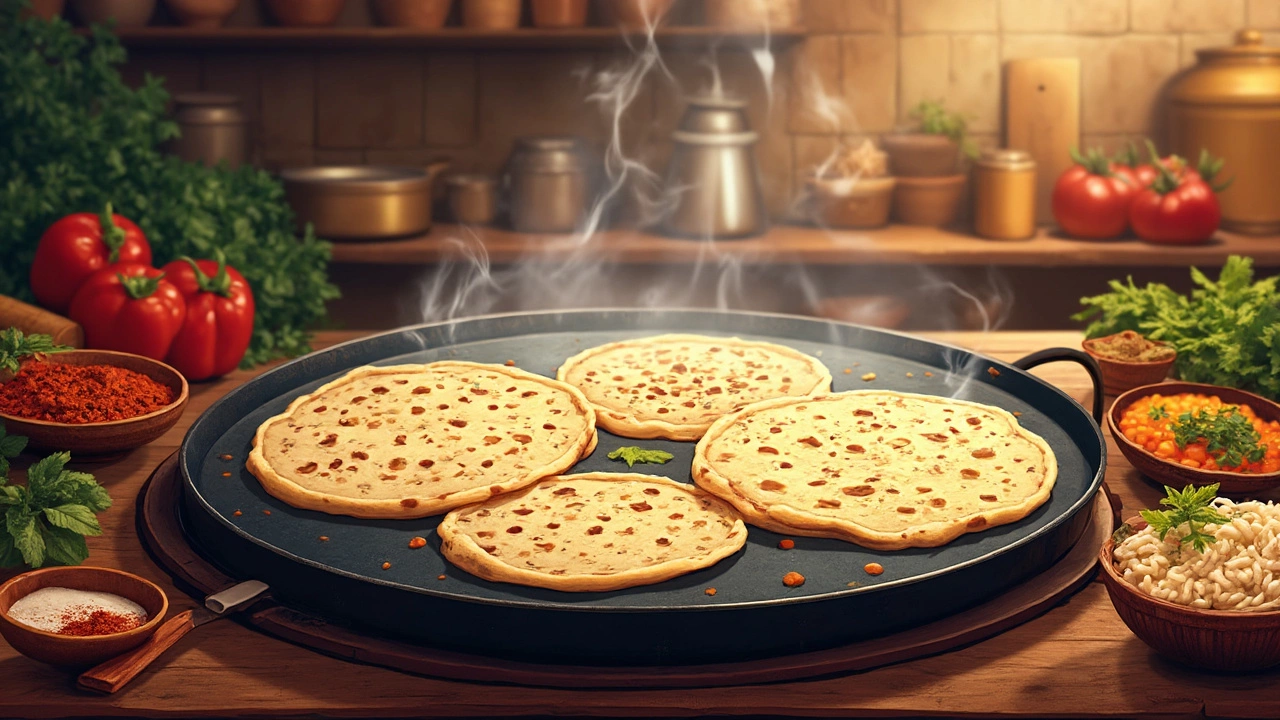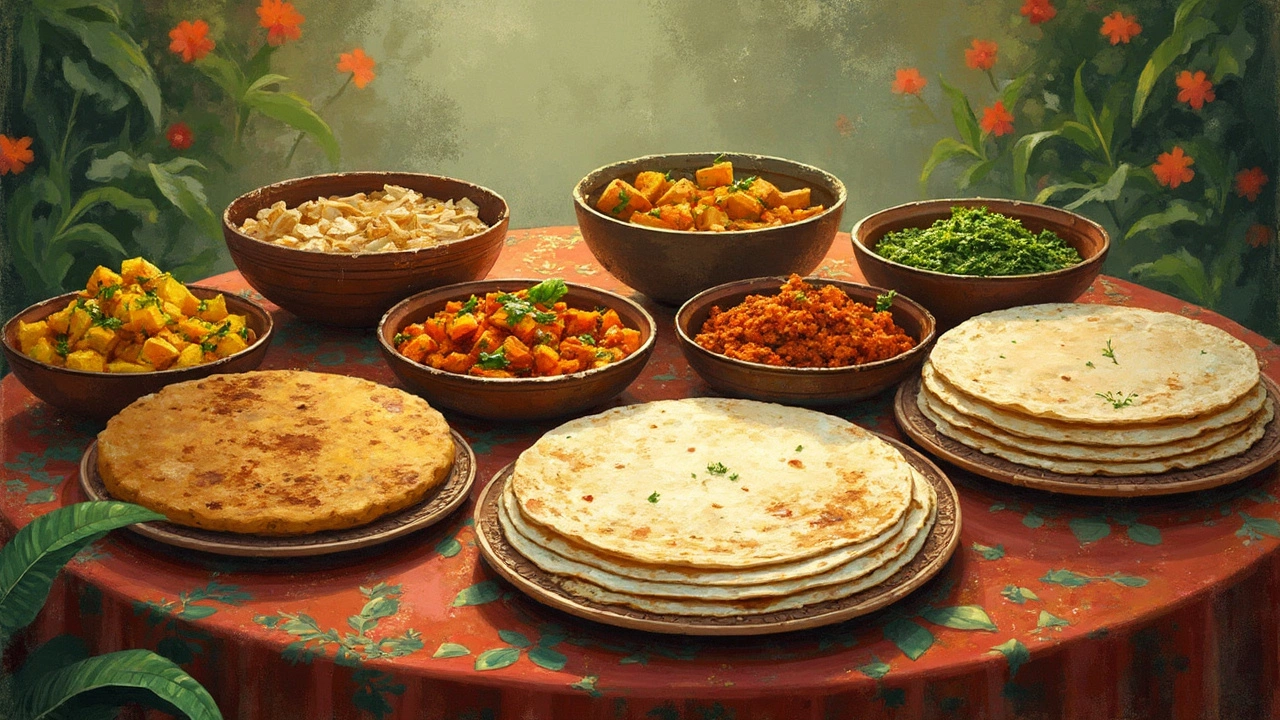Caloric Density of Roti: Why It Matters for Your Diet
 Feb, 20 2025
Feb, 20 2025
Ever wondered why the caloric density of roti is a buzzworthy topic? Well, it's all about making conscious decisions to suit your lifestyle without giving up the foods you love. So, when you talk about calories in 1 roti, you're essentially looking at how this staple can influence your energy intake.
On average, how much calories in 1 roti depends on the size and flour type. Typically, a standard homemade roti contains about 70 to 120 calories. Not too bad, right? But let's dive deeper into how you can incorporate roti in a smart way into your diet.
Embrace the versatility of roti by pairing it with veggies – or sabzi – for a balanced meal. Calories in 1 roti and sabzi might range depending on the vegetables, but it typically makes for a nutritious, satisfying choice.
- Understanding Caloric Density
- Calories in 1 Roti: Breaking it Down
- Pairing Roti with Sabzi: The Calorie Count
- Adding Ghee to Roti: The Impact
Understanding Caloric Density
What is caloric density, and why should it matter to you? Well, it's all about understanding the energy your food gives you per gram or ounce. Foods with a high caloric density have more calories for a small amount, while those with a low caloric density give you fewer calories for the same amount. Pretty straightforward, right?
Take our staple, roti, for instance. By itself, the calories in 1 roti aren't too daunting, but understanding its caloric density helps you manage your overall intake better. Think of it as playing Tetris with your food choices, where balancing your blocks (or calories) is key.
Steps to Use Caloric Density Wisely
- Read Labels: Whenever possible, check labels for caloric information. An informed choice is a wise choice.
- Portion Control: Keep an eye on your portion sizes. Enjoying a small piece of roti more frequently could work better than larger servings less often.
- Balance with Greens: Pair high caloric dense foods like roti with low caloric dense foods like salads to even out your meal.
If you're wondering about combinations, think of this: calories in 1 roti and sabzi could be just the right mix of energy and nutrients. The idea isn't to cut out what you enjoy but to make it fit in a way that's both satisfying and supportive of your goals.
To give you a clearer perspective, here's a simple comparison table:
| Food Item | Calories Per Serving |
|---|---|
| Plain Roti | 70 - 120 |
| Roti with Ghee | 100 - 150 |
| Roti with Sabzi | 150 - 250 (Varies with Sabzi) |
Next time you plan a meal, think of caloric density as your new tool. It's not about eating less, but about eating smarter, ensuring that things like roti with a bit of ghee can be enjoyed guilt-free and fit perfectly into your balance.
Calories in 1 Roti: Breaking it Down
Alright, let’s get into the nitty-gritty of how many calories in 1 roti you’re dealing with. Understanding this can help you make better dietary choices and maintain a balanced intake.
The Basics of Roti Calories
Typically, a homemade roti made from whole wheat flour has about 70 to 120 calories. The variation mainly comes from the size and thickness. Thicker rotis or those made with refined flour will crank up the calorie count.
If you're a fan of ghee, slathering just a teaspoon of it on your roti can add about 45 calories more. Suddenly, that humble roti with a dollop of ghee reaches around 115-165 calories. Quite an upgrade, eh? But hey, every calorie has its place in your diet, right?
Factors Affecting Caloric Content
- Flour Type: Rotis made with whole wheat have fewer calories compared to those with refined flour.
- Serving Size: Larger or thicker rotis pack more calories.
- Additions: Adding ghee or butter influences the calorie count significantly.
"Eating a balanced diet by including traditional foods like roti is essential for sustaining energy and overall health," says Dr. Priya Tiwari, a leading nutritionist. "But understanding portion control and caloric density helps in smart meal planning."
How to Balance Roti in Your Diet
Alright, so what's the best way to enjoy your rotis without overdoing it? Here’s a quick guide:
- Watch the Size: Stick to regular-sized rotis to keep calories in check.
- Mind the Add-ons: Consider alternatives like yogurt instead of ghee.
- Balance with Veggies: Pair roti with nutrient-rich sabzis to keep energy levels up.
To sum it up, being aware of these factors can help you enjoy your favorite meals while keeping your calorie intake aligned with your health goals. So next time, when someone asks how much calories in 1 roti, you'll know exactly what to say!

Pairing Roti with Sabzi: The Calorie Count
Pairing a humble roti with nutritious sabzi isn't just a delightful combination for your taste buds—it's a smart way to balance your meals. But how do calories in 1 roti and sabzi add up? Let's break it down together.
Benefits of Eating Roti and Sabzi Together
Pairing vegetables with roti can up your nutrient intake without overshooting your calorie count. A simple vegetable curry or stir-fry can vary greatly in calories, depending on preparation. A common serving, with minimal oil and rich leafy greens or colorful veggies, can range somewhere between 100 to 150 calories. When combined with a single roti, you're looking at a wholesome meal under 300 calories.
Creating a Balanced Meal
Here's how you can ensure your roti and sabzi meal remains balanced:
- Focus on variety: Rotate different vegetables like spinach, carrots, and peas to keep it interesting and meet various nutrient needs.
- Mind the oil: Use oils like olive or mustard in moderation to keep calorie contribution low.
- Portion Control: Stick to one to two rotis per meal. While a single roti might seem small, it adds up when combined with calorie-rich side dishes.
Swapping high-calorie dinners with roti and sabzi can be an effective way to cut down on unnecessary calorie intake, without sacrificing flavor.
A Sample Calorie Distribution
| Item | Calories |
|---|---|
| 1 Roti | 80 |
| 1 Serving Mixed Sabzi | 130 |
| Total | 210 |
So next time someone asks how many calories in 1 roti with sabzi, you'll know exactly what to say. This combo is about achieving balance and making mindful choices that support your health and wellbeing. Enjoy your meal!
Adding Ghee to Roti: The Impact
If you're like many who enjoy the richness of ghee on their roti, let's look at what it really means for your diet. Adding a spoonful of ghee not only increases the flavor, but it also bumps up the calorie count.
So, how many calories in 1 roti with ghee? A typical roti carries around 70 to 120 calories, but when you add a teaspoon of ghee, you're looking at an additional 45 calories. That can be a lot or not, depending on your overall dietary goals.
Why Add Ghee?
Ghee is rich in vitamins A, D, E, and K, and provides healthy fats. Not to mention, it gives your roti that irresistible aroma and taste. This could be a positive addition if you need extra calories and nutrients.
Balancing Flavors and Nutrition
Moderation is key. Here's a simple step-by-step guide on how to enjoy roti with ghee without overdoing it:
- Assess your needs: Consider your daily calorie intake and understand where a buttery roti fits.
- Limit portions: Enjoy smaller servings with ghee, balancing with plain roti or whole grains.
- Explore alternatives: Try using less ghee or pairing with nutrient-rich sabzi for a complete meal.
Remember, it's all about balance. By knowing how much calories in 1 roti change with ghee, you can make choice that suits your taste and health goals. If you occasionally prefer a bit of indulgence, that's okay. Ensure the rest of your diet keeps you on track.
Quick Calorie Comparison
| Item | Calories |
|---|---|
| 1 Roti | 70-120 |
| 1 Teaspoon Ghee | 45 |
| 1 Roti with Ghee | 115-165 |
So enjoy your calories in 1 roti with ghee wisely. The key is in the mindful pairing and portion control.